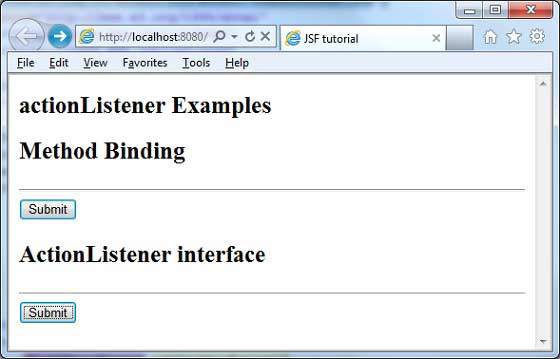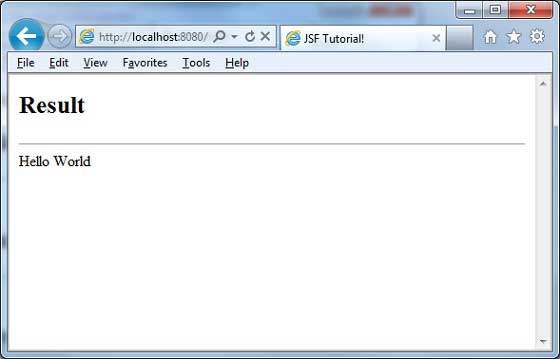
- JSF Tutorial
- JSF - Home
- JSF - Overview
- JSF - Environment Setup
- JSF - Architecture
- JSF - Life Cycle
- JSF - First Application
- JSF - Managed Beans
- JSF - Page Navigation
- JSF - Basic Tags
- JSF - Facelet Tags
- JSF - Convertor Tags
- JSF - Validator Tags
- JSF - DataTable
- JSF - Composite Components
- JSF - Ajax
- JSF - Event Handling
- JSF - JDBC Integration
- JSF - Spring Integration
- JSF - Expression Language
- JSF - Internationalization
- JSF Useful Resources
- JSF - Quick Guide
- JSF - Useful Resources
- JSF - Discussion
JSF - actionListener
When the user interacts with the components, such as h:commandButton or h:link, the JSF fires action events which can be handled in two ways.
| S.No | Technique & Description |
|---|---|
| 1 | Method Binding Pass the name of the managed bean method in actionListener attribute of UI Component. |
| 2 | ActionListener Implement ActionListener interface and pass the implementation class name to actionListener attribute of UI Component. |
Method Binding
Define a method
public void updateData(ActionEvent e) {
data = "Hello World";
}
Use the above method
<h:commandButton id = "submitButton"
value = "Submit" action = "#{userData.showResult}"
actionListener = "#{userData.updateData}" />
</h:commandButton>
ActionListener
Implement ActionListener
public class UserActionListener implements ActionListener {
@Override
public void processAction(ActionEvent arg0)
throws AbortProcessingException {
//access userData bean directly
UserData userData = (UserData) FacesContext.getCurrentInstance().
getExternalContext().getSessionMap().get("userData");
userData.setData("Hello World");
}
}
Use listener method
<h:commandButton id = "submitButton1"
value = "Submit" action = "#{userData.showResult}" >
<f:actionListener type = "com.tutorialspoint.test.UserActionListener" />
</h:commandButton>
Example Application
Let us create a test JSF application to test the actionListener in JSF.
| Step | Description |
|---|---|
| 1 | Create a project with a name helloworld under a package com.tutorialspoint.test as explained in the JSF - First Application chapter. |
| 2 | Modify UserData.java file as explained below. |
| 3 | Create UserActionListener.java file under a package com.tutorialspoint.test. Modify it as explained below. |
| 4 | Modify home.xhtml as explained below. Keep the rest of the files unchanged. |
| 5 | Modify result.xhtml as explained below. Keep the rest of the files unchanged. |
| 6 | Compile and run the application to make sure the business logic is working as per the requirements. |
| 7 | Finally, build the application in the form of war file and deploy it in Apache Tomcat Webserver. |
| 8 | Launch your web application using appropriate URL as explained below in the last step. |
UserData.java
package com.tutorialspoint.test;
import java.io.Serializable;
import java.util.LinkedHashMap;
import java.util.Map;
import javax.faces.bean.ManagedBean;
import javax.faces.bean.SessionScoped;
import javax.faces.event.ValueChangeEvent;
@ManagedBean(name = "userData", eager = true)
@SessionScoped
public class UserData implements Serializable {
private static final long serialVersionUID = 1L;
private static Map<String,String> countryMap;
private String data = "sample data";
public String showResult() {
return "result";
}
public void updateData(ActionEvent e) {
data="Hello World";
}
public String getData() {
return data;
}
public void setData(String data) {
this.data = data;
}
}
UserActionListener.java
package com.tutorialspoint.test;
import javax.faces.context.FacesContext;
import javax.faces.event.AbortProcessingException;
import javax.faces.event.ActionEvent;
import javax.faces.event.ActionListener;
public class UserActionListener implements ActionListener {
@Override
public void processAction(ActionEvent arg0)
throws AbortProcessingException {
//access userData bean directly
UserData userData = (UserData) FacesContext.getCurrentInstance().
getExternalContext().getSessionMap().get("userData");
userData.setData("Hello World");
}
}
home.xhtml
<?xml version = "1.0" encoding = "UTF-8"?>
<!DOCTYPE html PUBLIC "-//W3C//DTD XHTML 1.0 Transitional//EN"
"http://www.w3.org/TR/xhtml1/DTD/xhtml1-transitional.dtd">
<html xmlns = "http://www.w3.org/1999/xhtml"
xmlns:h = "http://java.sun.com/jsf/html"
xmlns:f = "http://java.sun.com/jsf/core">
<h:head>
<title>JSF tutorial</title>
</h:head>
<h:body>
<h2>actionListener Examples</h2>
<h:form>
<h2>Method Binding</h2>
<hr/>
<h:commandButton id = "submitButton"
value = "Submit" action = "#{userData.showResult}"
actionListener = "#{userData.updateData}" />
</h:commandButton>
<h2>ActionListener interface</h2>
<hr/>
<h:commandButton id = "submitButton1"
value = "Submit" action = "#{userData.showResult}" >
<f:actionListener
type = "com.tutorialspoint.test.UserActionListener" />
</h:commandButton>
</h:form>
</h:body>
</html>
result.xhtml
<?xml version = "1.0" encoding = "UTF-8"?>
<!DOCTYPE html PUBLIC "-//W3C//DTD XHTML 1.0 Transitional//EN"
"http://www.w3.org/TR/xhtml1/DTD/xhtml1-transitional.dtd">
<html xmlns = "http://www.w3.org/1999/xhtml"
xmlns:f = "http://java.sun.com/jsf/core"
xmlns:h = "http://java.sun.com/jsf/html">
<h:head>
<title>JSF Tutorial!</title>
</h:head>
<h:body>
<h2>Result</h2>
<hr />
#{userData.data}
</h:body>
</html>
Once you are ready with all the changes done, let us compile and run the application as we did in JSF - First Application chapter. If everything is fine with your application, this will produce the following result.

Click any submit button. You will see the following result.
